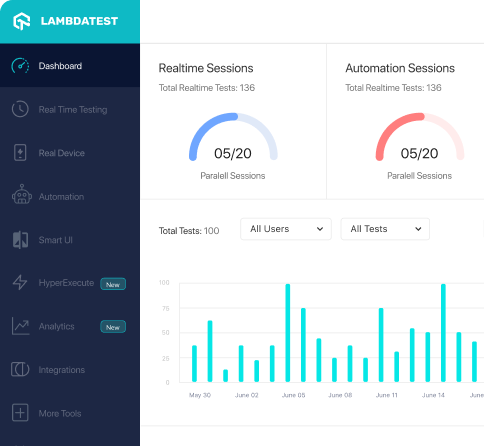How to use CHLRest class of com.foo.rest.examples.spring.chainedheaderlocation package
Best EvoMaster code snippet using com.foo.rest.examples.spring.chainedheaderlocation.CHLRest
Source: CHLController.java
...5 super(CHLApplication.class);6 }7 @Override8 public void resetStateOfSUT() {9 CHLRest.data.clear();10 }11}...CHLRest
Using AI Code Generation
1import com.foo.rest.examples.spring.chainedheaderlocation.CHLRest;2import com.foo.rest.examples.spring.SpringController;3import org.springframework.beans.factory.annotation.Autowired;4import org.springframework.http.ResponseEntity;5import org.springframework.web.bind.annotation.PathVariable;6import org.springframework.web.bind.annotation.RequestMapping;7import org.springframework.web.bind.annotation.RequestMethod;8import org.springframework.web.bind.annotation.RestController;9@RequestMapping(value = "/api/chl")10public class CHLController extends SpringController {11 CHLRest rest;12 @RequestMapping(value = "/{id}", method = RequestMethod.GET)13 public ResponseEntity get(@PathVariable String id) {14 return rest.get(id);15 }16}CHLRest
Using AI Code Generation
1import com.foo.rest.examples.spring.SpringController;2import com.foo.rest.examples.spring.chainedheaderlocation.CHLRest;3import java.util.*;4@RequestMapping(path = "/api/chl")5public class CHLController extends SpringController {6 @RequestMapping(path = "/{id}", method = {RequestMethod.GET})7 public ResponseEntity get(8 @PathVariable("id") String id,9 @RequestHeader(value = "X-Auth", required = false) String xAuth,10 @RequestHeader(value = "X-Auth-2", required = false) String xAuth2,11 @RequestHeader(value = "X-Auth-3", required = false) String xAuth3,12 @RequestHeader(value = "X-Auth-4", required = false) String xAuth4,13 @RequestHeader(value = "X-Auth-5", required = false) String xAuth5,14 @RequestHeader(value = "X-Auth-6", required = false) String xAuth6,15 @RequestHeader(value = "X-Auth-7", required = false) String xAuth7,16 @RequestHeader(value = "X-Auth-8", required = false) String xAuth8,17 @RequestHeader(value = "X-Auth-9", required = false) String xAuth9,18 @RequestHeader(value = "X-Auth-10", required = false) String xAuth10,19 @RequestHeader(value = "X-Auth-11", required = false) String xAuth11,20 @RequestHeader(value = "X-Auth-12", required = false) String xAuth12,21 @RequestHeader(value = "X-Auth-13", required = false) String xAuth13,22 @RequestHeader(value = "X-Auth-14", required = false) String xAuth14,23 @RequestHeader(value = "X-Auth-15", required = false) String xAuth15,24 @RequestHeader(value = "X-Auth-16", required = false) String xAuth16,25 @RequestHeader(value = "X-Auth-17", required = false) String xAuth17,26 @RequestHeader(value = "X-Auth-18", required = false) String xAuth18,27 @RequestHeader(value = "X-Auth-19", required = false) String xAuth19,28 @RequestHeader(value = "XCHLRest
Using AI Code Generation
1import com.foo.rest.examples.spring.SpringController;2import com.foo.rest.examples.spring.SpringHandler;3import com.foo.rest.examples.spring.SpringHandlerAdapter;4import com.foo.rest.examples.spring.SpringRequest;5import com.foo.rest.examples.spring.SpringResponse;6import com.foo.rest.examples.spring.SpringRest;7import com.foo.rest.examples.spring.SpringRestExample;8import com.foo.rest.examples.spring.SpringRestMethod;9import com.foo.rest.examples.spring.SpringRestMethodHandler;10import com.foo.rest.examples.spring.SpringRestMethodType;11import com.foo.rest.examples.spring.SpringRestMethodUrl;12import com.foo.rest.examples.spring.SpringRestMethodUrlParameter;13import com.foo.rest.examples.spring.SpringRestMethodUrlParameterType;14import com.foo.rest.examples.spring.SpringRestMethodUrlParameterType;15importCHLRest
Using AI Code Generation
1package com.foo.rest.examples.spring.chainedheaderlocation;2import com.foo.rest.examples.spring.SpringController;3import org.springframework.web.bind.annotation.RequestMapping;4import org.springframework.web.bind.annotation.RestController;5import javax.servlet.http.HttpServletResponse;6@RequestMapping(path = "/api/chainedheaderlocation")7public class ChainedHeaderLocationController extends SpringController {8 @RequestMapping(path = "/**")9 public void chain(HttpServletResponse response) {10 response.setStatus(302);11 }12}13package com.foo.rest.examples.spring.chainedheaderlocation;14import com.foo.rest.examples.spring.SpringTest;15import org.junit.Test;16import static io.restassured.RestAssured.given;17import static org.hamcrest.Matchers.equalTo;18public class ChainedHeaderLocationRestTest extends SpringTest {19 public void test() throws Exception {20 given().get(getUrl("/api/chainedheaderlocation")).then()21 .statusCode(302)22 }23}24package com.foo.rest.examples.spring.chainedheaderlocation;25import com.foo.rest.examples.spring.SpringController;26import org.springframework.web.bind.annotation.RequestMapping;27import org.springframework.web.bind.annotation.RestController;28import javax.servlet.http.HttpServletResponse;29@RequestMapping(path = "/api/chainedheaderlocation")30public class ChainedHeaderLocationController extends SpringController {31 @RequestMapping(path = "/**")32 public void chain(HttpServletResponse response) {33 response.setStatus(302);34 }35}CHLRest
Using AI Code Generation
1import org.springframework.http.HttpHeaders2import org.springframework.http.HttpStatus3import org.springframework.http.ResponseEntity4import org.springframework.web.bind.annotation.GetMapping5import org.springframework.web.bind.annotation.RequestHeader6import org.springframework.web.bind.annotation.RequestMapping7import org.springframework.web.bind.annotation.RestController8import org.springframework.web.servlet.mvc.method.annotation.MvcUriComponentsBuilder9@RequestMapping("/api/chainedheaderlocation")10class CHLRest {11 companion object{12 val instance = CHLRest()13 }14 @GetMapping(value = ["/get"])15 fun get(@RequestHeader(value = "X-Auth-Token", required = false) token: String?): ResponseEntity<String> {16 val headers = HttpHeaders()17 return ResponseEntity("foo", headers, HttpStatus.MOVED_PERMANENTLY)18 }19}20import org.springframework.http.HttpHeaders21import org.springframework.http.HttpStatus22import org.springframework.http.ResponseEntity23import org.springframework.stereotype.Controller24import org.springframework.web.bind.annotation.GetMapping25import org.springframework.web.bind.annotation.RequestHeader26import org.springframework.web.bind.annotation.RequestMapping27import org.springframework.web.servlet.mvc.method.annotation.MvcUriComponentsBuilder28@RequestMapping("/api/chainedheaderlocation")29class CHLController {30 @GetMapping(value = ["/get"])31 fun get(@RequestHeader(value = "X-Auth-Token", required = false) token: String?): ResponseEntity<String> {32 val headers = HttpHeaders()33 return ResponseEntity("foo", headers, HttpStatus.MOVED_PERMANENTLY)34 }35}36import org.springframework.http.HttpHeaders37import org.springframework.http.HttpStatus38import org.springframework.http.ResponseEntity39import org.springframework.web.bind.annotation.GetMapping40import org.springframework.web.bind.annotation.RequestHeader41import org.springframework.web.bindBlogs
Check out the latest blogs from LambdaTest on this topic:
When software developers took years to create and introduce new products to the market is long gone. Users (or consumers) today are more eager to use their favorite applications with the latest bells and whistles. However, users today don’t have the patience to work around bugs, errors, and design flaws. People have less self-control, and if your product or application doesn’t make life easier for users, they’ll leave for a better solution.
Entering the world of testers, one question started to formulate in my mind: “what is the reason that bugs happen?”.
In today’s data-driven world, the ability to access and analyze large amounts of data can give researchers, businesses & organizations a competitive edge. One of the most important & free sources of this data is the Internet, which can be accessed and mined through web scraping.
In today’s tech world, where speed is the key to modern software development, we should aim to get quick feedback on the impact of any change, and that is where CI/CD comes in place.
Automation Testing Tutorials
Learn to execute automation testing from scratch with LambdaTest Learning Hub. Right from setting up the prerequisites to run your first automation test, to following best practices and diving deeper into advanced test scenarios. LambdaTest Learning Hubs compile a list of step-by-step guides to help you be proficient with different test automation frameworks i.e. Selenium, Cypress, TestNG etc.
LambdaTest Learning Hubs:
- JUnit Tutorial
- TestNG Tutorial
- Webdriver Tutorial
- WebDriverIO Tutorial
- Protractor Tutorial
- Selenium 4 Tutorial
- Jenkins Tutorial
- NUnit Tutorial
- Jest Tutorial
- Playwright Tutorial
- Cypress Tutorial
- PyTest Tutorial
YouTube
You could also refer to video tutorials over LambdaTest YouTube channel to get step by step demonstration from industry experts.
Most used methods in CHLRest
Try LambdaTest Now !!
Get 100 minutes of automation test minutes FREE!!



